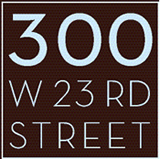Our Historical Neighborhood – An Anecdotal History of New York City with Glimpses into the Past of Particular Relevance to 300 West 23rd Street
Our neighbor Joe Polacek offers us this look at our surroundings – part memoir and part historical discourse – to enhance our appreciation for our building and neighborhood.
Chapter 1
Since we at 300 West 23rd Street live in the middle of an interesting and historic area, in addition to living in an interesting building, I thought I would do a mini-series to increase your enjoyment of this fascinating area we call home.
Lower Manhattan was first called New Amsterdam and a wall was build at its northern-most boundary to protect the settlers from the English and the Indians. Wall Street runs where that wall originally stood. For further protection and transportation, a canal was dug from east to west further uptown from the wall; when this was later filled in, it became Canal Street.
From its original site at Broadway and Murray Street, the new Columbia University was built a half-day’s journey up Broadway, at 116th Street. Later, some enterprising builders built a luxury apartment house at Central Park West at 72nd Street. Because it was so far from downtown, people said you “might as well be living in the Dakotas.” The name stuck, and that building is well known for both its architecture and for the individuals who live there.
Between lower Manhattan and Columbia University, many interesting areas developed, such as Greenwich Village, Chelsea, Murray Hill, etc. We will center our attention on Chelsea.
Clement Moore, the author of “The Night Before Christmas,” lived downtown but had a farm in what’s now our area. His farmhouse (and I believe where he wrote his famous story) stood on the southwest corner of 23rd Street and 9th Avenue. What really makes Moore so important to us is that when he died, he left the farm to St. Peter’s Church on 20th Street, between 8th and 9th Avenues, with the stipulation that no building on that property will be built higher than the church steeple. Hence, those of us on the south and west sides of our building benefit from the (mostly) unobstructed view.
For those of you who have not had the pleasure of walking down the blocks surrounding the seminary, on 9th Avenue between 20th and 21st Streets, I recommend it. Go through the entrance on 9th Avenue and into the seminary courtyard. If you take a camera and photograph the gardens and the 19th century buildings, you could easily show the pictures to anyone and say you took them in England. Just beyond the west wall of the seminary, on 10th Avenue, was the Hudson River water line and the piers.
In days gone by, sailors whose ships docked at the 23rd Street pier would walk one block east to shop for provisions at the northeast corner of 24th Street and 10th Avenue. This supply store still exists as the Chelsea Commons restaurant. On a nice day, if you are sitting in the backyard of the restaurant, you can almost touch the wall of the “ice house.” This small structure served the landmark house next to it. I remember some years ago an ongoing battle between the owners of that house and city officials. The city claimed the ice house was an illegal structure, since it was not registered on maps of the area. The owners, realizing they had an historic edifice, fought the city and won, thus preserving a piece of history.
Our building was built at the same time the London Terrace apartments were constructed. The London Terrace complex of apartment buildings was the largest in the world at that time. The apartments were rented with very basic furniture and utensils. The furnishings allowed landlords to charge higher rents.
Our building opened with two months’ free rent when you signed your lease. It was an elegant building for the area, with the opera house across the street, on the northwest corner. We had doormen and elevator operators 24 hours a day. The back lobby office spa was the original mail room. A staff member stood in the room, which had a dutch door, and handed tenants their mail on a silver tray. The attendant wore white gloves and a formal uniform. Later, residents collected their own mail in the same room in open pigeon holes.
The lobby was Spanish tile, with circular Spanish rugs and Spanish chairs and sofas scattered around. Table lamps stood on small side tables. Although the motif was Spanish, surprisingly there was a huge mural on the wall opposite the elevators. The mural was not colorful but rather an old-fashioned pen-and-ink drawing in sepia tones. It was an enlarged reprint of a cobblestone street, with circular mini-park and church in the background and passersby in the foreground.
![]() All documents are in Adobe Acrobat (PDF) format.
All documents are in Adobe Acrobat (PDF) format.
Need Free Acrobat reader software?
Click here.
© Copyright 300 W 23rd Building 2025
